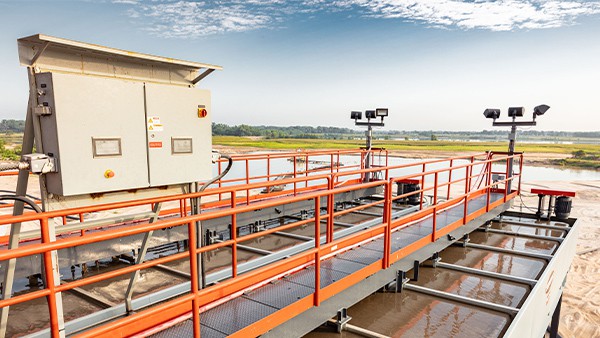Classifying Tank

Classifiers Blend to Exacting Specs
Common in dredging or sand applications that require removal — or scalping — of lots of water, Classifying Tanks are capable of accepting a variable out-of-spec feed and will produce a steady in-spec output.
Using a system of high-pressure valves that are computer-controlled, feed material is blended together according to your inputted spec.
Sand classifiers can produce as many as two spec products and one excess product.
Applications:
Manufactured Sand
Sand & Gravel
Fines Retention
Dredging
Water Scalping
Advantages

01.
Elevated Valve Bridge
At least 6” higher than competitors, which prevents water from damaging mechanical parts.

02.
Control System
Computer controls maintain tight specifications, can be controlled from anywhere, and save spec recipes.

03.
Valve Station
High pressure hydraulic hoses encourage faster valve opening and closing, which achieves a more precise spec.

04.
Recirculating Pump
Reduces water usage by recycling tank overflow to the rising current cells.

How Does A Classifying Tank Work?
A sand/slurry mix is pumped into the tank through a feedbox. Particles drop in the tank as the velocity of the water slows and allows the material to settle. The coarsest, heaviest sand falls earliest in the process while finer sands settle at the end of the tank.
At the bottom of the tank, valves open and close at different intervals releasing a specific amount of sand from each station. This motion is controlled by the computer according to the blended specs you entered.
Local Stock. Local Support. Local Experts!
Comparing Classifying Technology
When it comes to technology for classifying dry bulk materials, classifiers and sizers are often compared. This table will help you separate broad features of each.
Classifying Tank
Application
Blending of construction aggregates.
Action
Feed is separated and blended into spec products.
Feed equipment
Accepts feed from multiple types of equipment.
feed material
Handles variable feed well.
Water usage
High
Yield
Unit overflow can displace valuable fine sands.
footprint
Large
Maintenance
Multiple moving valves and gauges per station.
Density Sizer
Application
Specialty products like frac or filter sands and glass.
Action
Extremely sharp cut splits feed in two.
Feed equipment
Typically only takes its feed from hydrocyclones.
feed material
Works best when feed is consistent.
Water usage
Low
Yield
No overflow products lost to waste pond.
footprint
Compact
Maintenance
Less with only one moving part to maintain.
Videos
Classifying Tanks are included in Lyman-Richey’s compact washing plant.
Cemstone Products appreciates the precision of material from a Classifying Tank.
Saylorcreek Sand Company uses a Classifying Tank for scalping water from dredge feed.
models
Models
Compare Classifying Tanks
Download the product literature to see skid-mounted and portable models.
Back to top »
Have questions? Need a quote? Complete the form below and we will follow up shortly.
Request More Info | Classifying Tank
See our privacy policy.














